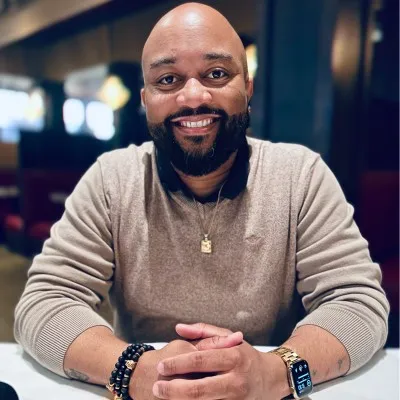Five years ago, when my last startup was acquired, I started the bittersweet search for my next Sales Engineer (SE) leadership gig. After a 20 year career in PreSales working with some of the best AEs and SEs in enterprise software, I learned a few things about the sales and SE process.
I had an interesting idea for my upcoming interviews. The 6-8 interviews are typically 100% verbal. What about building a deck to help communicate my thoughts and ideas for how to transform their current SE department?
Below are some sample slides I’ve used. I typically don’t show the whole deck to every interviewer; sometimes a topic like “how would you handle POCs” comes up and I can bring the relevant slide up.
Since I started to speak with C-level executives during the interview process, I brought the deck up a level and started with “what SE means to the C suite”. Depending who I’m speaking with (CRO vs. CPO), I can pivot to relevant talking points. This slide also conveys that SEs make an impact throughout the organization.
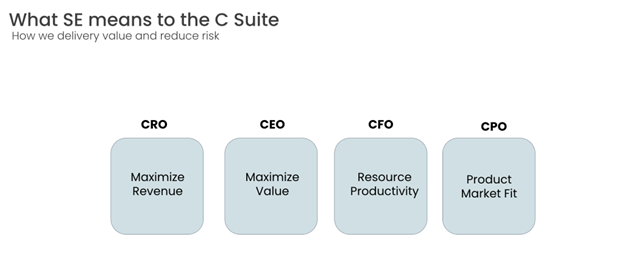
From there, I pivot to “typical challenges.” During leadership interviews, we typically get this level of questioning. Why not tackle this topic head-on, diffuse the question itself, and bring up points the interviewer hasn’t thought about?
This is a great sales tactic to get ahead of concerns and start to gain trust. Notice how the bolded red addresses a key issue in the SE world: retaining your best players. We all know how hard it is to replace good SEs. Also, notice the green bubble for talking about cross-functional collaboration. This is a very important topic and underscores the impact the SE department has on a company.
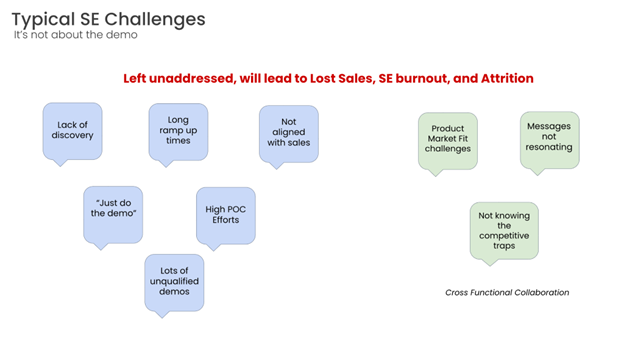
Part of my leadership SE speak during interviews is the rollout of an “SE playbook.” Earlier in my career as an individual contributor, I learned some sales best practices while at Siebel, Ariba, and Endeca, in addition to months of sales and SE training. I used those best practices and added my own components to the playbook. I have other slides on this, but here’s a summary of the playbook:
Discovery Questionnaire
- Discovery is the most important part of the sales process.
- Role play so SEs learn how to double-click with clarifying questions.
Value and Differentiator Messaging
- Use what we learn in discovery to customize your pitch.
- What are the gaps compared to our competition? Close those.
- What are our strengths compared to our competition? Emphasize those.
Skills Matrix
- Technical skills — track gaps and aptitude. Have a plan to up-level SEs.
- Sales skills — we are still sellers. Role play discovery, demos, objection handling, and closing the technical win.
Demo Flow and Objection Handling
- Roll out the “Tell, Show, Tell” demo methodology.
- Limbic openers, i.e. tell a story that will resonate with some design graphics at the beginning and end. Be memorable.
- Document common questions and objections. We should have the “best” answer ready at our fingertips.
Demo Frameworks
- Our customers' businesses are not alike, nor should our demos be. In addition to custom messaging, create custom demos for each type of customer. On top of that, add custom data and workflows, to create higher chances of resonating with the buyer.
Product Market Fit
- Markets change and competitors add features often. Since SEs are the “tip of the spear” in the field, we hear these changes faster than other internal departments.
- Implement a process to capture changes and gaps and feed them back to product, engineering, and marketing.
POC Success Criteria
- Use a POC as a closing tool by getting the prospect to agree on success criteria, timing, schedule with resources (both sides), and most importantly, ”What happens next if we succeed on the criteria?”
- Offer frequent checkpoints to ensure POC is on point, but also build the relationships and most importantly, develop trusted advisor status.
Here’s another slide I jump to when an interviewer asks about motivating the team or measuring performance. On the analytics side, it was important for our SE group to understand how much effort we were spending on POCs and when POCs were being introduced. We learned by moving them to the end of a sales cycle and capturing all the information as described in the last bullet point above, we were able to increase our POC technical win rate from 50% to 81% — that’s a big move. CROs love this data; it helps them motivate the AEs to position deals correctly.

The slide below is great to show any CRO or CFO. How do we optimize SE tools and processes against the sales funnel? The goal is to be very efficient and not waste too much time at the top of the funnel. When the deal matures and the team gets a better understanding of the closing process, spend time where it matters. As said earlier, use the POC as a closing tool, as you can waste a lot of valuable SE time on unqualified POCs.

Full disclosure, the companies I’ve worked for the past 15 years have started in the 50-100 employee range, then scaled up from there.
You’ve probably seen content where you think, “why doesn’t product or marketing do that?” For companies even in the hundreds of employees range, SEs can provide massive impact by developing the tools, processes, and content themselves. We are the tip of the spear when it comes to hearing what the market is saying in near-real time. Plus, we will do whatever it takes to win deals and have success in the field.
Happy hunting in your next SE leadership role. Feel free to DM me on LinkedIn to talk SE processes, Sprinter Van conversions, or foil surfing!
Written by:
.png)
VP Global Sales Engineering
Lucidworks
Five years ago, when my last startup was acquired, I started the bittersweet search for my next Sales Engineer (SE) leadership gig. After a 20 year career in PreSales working with some of the best AEs and SEs in enterprise software, I learned a few things about the sales and SE process.
I had an interesting idea for my upcoming interviews. The 6-8 interviews are typically 100% verbal. What about building a deck to help communicate my thoughts and ideas for how to transform their current SE department?
Below are some sample slides I’ve used. I typically don’t show the whole deck to every interviewer; sometimes a topic like “how would you handle POCs” comes up and I can bring the relevant slide up.
Since I started to speak with C-level executives during the interview process, I brought the deck up a level and started with “what SE means to the C suite”. Depending who I’m speaking with (CRO vs. CPO), I can pivot to relevant talking points. This slide also conveys that SEs make an impact throughout the organization.

From there, I pivot to “typical challenges.” During leadership interviews, we typically get this level of questioning. Why not tackle this topic head-on, diffuse the question itself, and bring up points the interviewer hasn’t thought about?
This is a great sales tactic to get ahead of concerns and start to gain trust. Notice how the bolded red addresses a key issue in the SE world: retaining your best players. We all know how hard it is to replace good SEs. Also, notice the green bubble for talking about cross-functional collaboration. This is a very important topic and underscores the impact the SE department has on a company.

Part of my leadership SE speak during interviews is the rollout of an “SE playbook.” Earlier in my career as an individual contributor, I learned some sales best practices while at Siebel, Ariba, and Endeca, in addition to months of sales and SE training. I used those best practices and added my own components to the playbook. I have other slides on this, but here’s a summary of the playbook:
Discovery Questionnaire
- Discovery is the most important part of the sales process.
- Role play so SEs learn how to double-click with clarifying questions.
Value and Differentiator Messaging
- Use what we learn in discovery to customize your pitch.
- What are the gaps compared to our competition? Close those.
- What are our strengths compared to our competition? Emphasize those.
Skills Matrix
- Technical skills — track gaps and aptitude. Have a plan to up-level SEs.
- Sales skills — we are still sellers. Role play discovery, demos, objection handling, and closing the technical win.
Demo Flow and Objection Handling
- Roll out the “Tell, Show, Tell” demo methodology.
- Limbic openers, i.e. tell a story that will resonate with some design graphics at the beginning and end. Be memorable.
- Document common questions and objections. We should have the “best” answer ready at our fingertips.
Demo Frameworks
- Our customers' businesses are not alike, nor should our demos be. In addition to custom messaging, create custom demos for each type of customer. On top of that, add custom data and workflows, to create higher chances of resonating with the buyer.
Product Market Fit
- Markets change and competitors add features often. Since SEs are the “tip of the spear” in the field, we hear these changes faster than other internal departments.
- Implement a process to capture changes and gaps and feed them back to product, engineering, and marketing.
POC Success Criteria
- Use a POC as a closing tool by getting the prospect to agree on success criteria, timing, schedule with resources (both sides), and most importantly, ”What happens next if we succeed on the criteria?”
- Offer frequent checkpoints to ensure POC is on point, but also build the relationships and most importantly, develop trusted advisor status.
Here’s another slide I jump to when an interviewer asks about motivating the team or measuring performance. On the analytics side, it was important for our SE group to understand how much effort we were spending on POCs and when POCs were being introduced. We learned by moving them to the end of a sales cycle and capturing all the information as described in the last bullet point above, we were able to increase our POC technical win rate from 50% to 81% — that’s a big move. CROs love this data; it helps them motivate the AEs to position deals correctly.

The slide below is great to show any CRO or CFO. How do we optimize SE tools and processes against the sales funnel? The goal is to be very efficient and not waste too much time at the top of the funnel. When the deal matures and the team gets a better understanding of the closing process, spend time where it matters. As said earlier, use the POC as a closing tool, as you can waste a lot of valuable SE time on unqualified POCs.

Full disclosure, the companies I’ve worked for the past 15 years have started in the 50-100 employee range, then scaled up from there.
You’ve probably seen content where you think, “why doesn’t product or marketing do that?” For companies even in the hundreds of employees range, SEs can provide massive impact by developing the tools, processes, and content themselves. We are the tip of the spear when it comes to hearing what the market is saying in near-real time. Plus, we will do whatever it takes to win deals and have success in the field.
Happy hunting in your next SE leadership role. Feel free to DM me on LinkedIn to talk SE processes, Sprinter Van conversions, or foil surfing!
Written by:
.png)
VP Global Sales Engineering
Lucidworks
Five years ago, when my last startup was acquired, I started the bittersweet search for my next Sales Engineer (SE) leadership gig. After a 20 year career in PreSales working with some of the best AEs and SEs in enterprise software, I learned a few things about the sales and SE process.
I had an interesting idea for my upcoming interviews. The 6-8 interviews are typically 100% verbal. What about building a deck to help communicate my thoughts and ideas for how to transform their current SE department?
Below are some sample slides I’ve used. I typically don’t show the whole deck to every interviewer; sometimes a topic like “how would you handle POCs” comes up and I can bring the relevant slide up.
Since I started to speak with C-level executives during the interview process, I brought the deck up a level and started with “what SE means to the C suite”. Depending who I’m speaking with (CRO vs. CPO), I can pivot to relevant talking points. This slide also conveys that SEs make an impact throughout the organization.

From there, I pivot to “typical challenges.” During leadership interviews, we typically get this level of questioning. Why not tackle this topic head-on, diffuse the question itself, and bring up points the interviewer hasn’t thought about?
This is a great sales tactic to get ahead of concerns and start to gain trust. Notice how the bolded red addresses a key issue in the SE world: retaining your best players. We all know how hard it is to replace good SEs. Also, notice the green bubble for talking about cross-functional collaboration. This is a very important topic and underscores the impact the SE department has on a company.

Part of my leadership SE speak during interviews is the rollout of an “SE playbook.” Earlier in my career as an individual contributor, I learned some sales best practices while at Siebel, Ariba, and Endeca, in addition to months of sales and SE training. I used those best practices and added my own components to the playbook. I have other slides on this, but here’s a summary of the playbook:
Discovery Questionnaire
- Discovery is the most important part of the sales process.
- Role play so SEs learn how to double-click with clarifying questions.
Value and Differentiator Messaging
- Use what we learn in discovery to customize your pitch.
- What are the gaps compared to our competition? Close those.
- What are our strengths compared to our competition? Emphasize those.
Skills Matrix
- Technical skills — track gaps and aptitude. Have a plan to up-level SEs.
- Sales skills — we are still sellers. Role play discovery, demos, objection handling, and closing the technical win.
Demo Flow and Objection Handling
- Roll out the “Tell, Show, Tell” demo methodology.
- Limbic openers, i.e. tell a story that will resonate with some design graphics at the beginning and end. Be memorable.
- Document common questions and objections. We should have the “best” answer ready at our fingertips.
Demo Frameworks
- Our customers' businesses are not alike, nor should our demos be. In addition to custom messaging, create custom demos for each type of customer. On top of that, add custom data and workflows, to create higher chances of resonating with the buyer.
Product Market Fit
- Markets change and competitors add features often. Since SEs are the “tip of the spear” in the field, we hear these changes faster than other internal departments.
- Implement a process to capture changes and gaps and feed them back to product, engineering, and marketing.
POC Success Criteria
- Use a POC as a closing tool by getting the prospect to agree on success criteria, timing, schedule with resources (both sides), and most importantly, ”What happens next if we succeed on the criteria?”
- Offer frequent checkpoints to ensure POC is on point, but also build the relationships and most importantly, develop trusted advisor status.
Here’s another slide I jump to when an interviewer asks about motivating the team or measuring performance. On the analytics side, it was important for our SE group to understand how much effort we were spending on POCs and when POCs were being introduced. We learned by moving them to the end of a sales cycle and capturing all the information as described in the last bullet point above, we were able to increase our POC technical win rate from 50% to 81% — that’s a big move. CROs love this data; it helps them motivate the AEs to position deals correctly.

The slide below is great to show any CRO or CFO. How do we optimize SE tools and processes against the sales funnel? The goal is to be very efficient and not waste too much time at the top of the funnel. When the deal matures and the team gets a better understanding of the closing process, spend time where it matters. As said earlier, use the POC as a closing tool, as you can waste a lot of valuable SE time on unqualified POCs.

Full disclosure, the companies I’ve worked for the past 15 years have started in the 50-100 employee range, then scaled up from there.
You’ve probably seen content where you think, “why doesn’t product or marketing do that?” For companies even in the hundreds of employees range, SEs can provide massive impact by developing the tools, processes, and content themselves. We are the tip of the spear when it comes to hearing what the market is saying in near-real time. Plus, we will do whatever it takes to win deals and have success in the field.
Happy hunting in your next SE leadership role. Feel free to DM me on LinkedIn to talk SE processes, Sprinter Van conversions, or foil surfing!
Written by:
.png)
VP Global Sales Engineering
Lucidworks




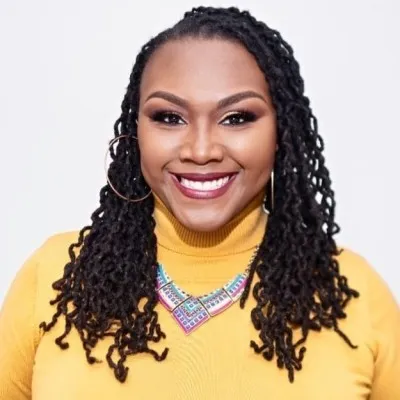
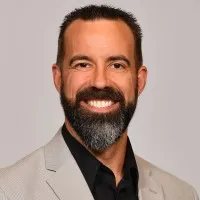
.webp)

